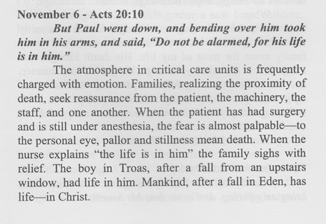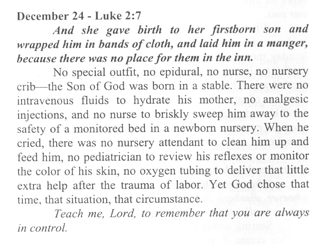Seeing Patients with Religious Texts
Seeing patients also textures Terri’s writing associated with her religious worship. Terri was raised in a very religious family that attended church regularly, and one of her grandfathers and several of her uncles were preachers. Terri’s religious worship continued in her adult life. Starting in the late 1990s, she began attending the Episcopal Church.
In the late 1990s, while working as an administrative assistant at a nursing home, Terri started writing a religious devotional. As her work on the devotional gained momentum, she took some time off from her job so that she could devote more time to finish it and pursue avenues for publication. Within six months, her devotional was published by a small press, and Terri was able to distribute copies to members of her family and close friends. The devotional's three hundred and sixty five entries each consist of a Bible verse, an anecdote or experience that illuminates something about the verse, and then end with a brief prayer related to the verse. Terri stated that she used The Book of Common Prayer, a central text of the Episcopal faith, as a loose guide to determine which passages to use and in which order (which day they would be used for). Terri also drew heavily upon her experiences as a health care professional: “I used a lot of my experience working in health care to help explain a lot of the biblical passages listed in The Book of Common Prayer. I had taken some time off from working in health care administration to write the devotional, so all of those events and memories were right there with me.” Of the 365 entries, 13 of them reference issues of health care in detail, and a dozen others make oblique references.
We offer two entries from Terri’s devotional as representative examples of the entries in which she draws upon her experiences working in health care. In the entry she crafted for November 6 (see Figure 3 at the left), Terri describes a scene in a critical care unit to prompt readers to reflect on the promise of eternal life through God. Evoking her own experiences from working in critical care, Terri’s account of the nurse helping the critically ill patient echoes Paul’s returning of life to Euryalus, the boy in Troas who died from a fall from a window but was promised the reassurance of eternal life through God. Terri’s account of the nurse in the critical care unit draws parallels between the life in the critically ill patient, the life returning to the boy from Troas, and the eternal life offered to mankind.
Terri’s experiences in health care also inform the entry for December 24 (see Figure 4 at the right). In this entry, Terri describes a scene in a contemporary delivery room as a means of reminding readers to trust in God’s plan for their lives. Contrasting Jesus’s birth in a humble manger, announced in Luke 2:7, to the more favorable conditions available for contemporary births, Terri encourages readers to know that no matter the setting and circumstances, God is always in control and to trust in Him.
As with her poetry and her science fiction, Terri’s seeing of patients as a nurse is woven into her engagement with religious texts and with religious worship more broadly. Her comment that her “experiences and memories” of working in direct care “were right there with [her]” as she drafted the religious devotional she wrote and had published and the numerous entries that reference her work in health care indicate that her work as a health care professional played a central role. During our interviews, Terri never indicated, as she did when discussing her poetry and her research for the planned science fiction novel, that her work on the devotional informed her seeing of patients as a nurse. Still, our sense is that Terri’s religious engagements animate her work as a nurse in a number of ways. One way this is evident is in Terri’s “One Nurse’s Prayer” poem, a poem written in the form of a prayer in which Terri asked for God’s help in seeing and treating her patients. It is not difficult to imagine Terri marshaling her faith in other ways as she interacts with patients, perhaps through reflecting on Bible verses during her shift or perhaps by offering prayers on behalf of the patients under her care or the caregivers she worked with.


